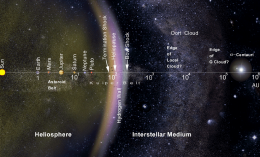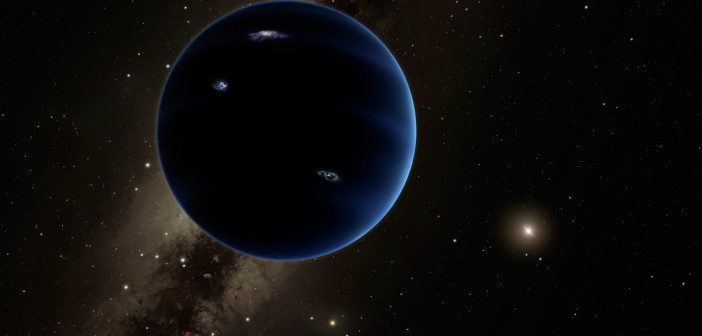The recent discovery that the orbits of some Kuiper belt objects (KBOs) share properties has proved puzzling. A pair of scientists have now proposed a bold explanation: there may be a planet-sized object yet undetected in our solar system.
Mysterious Clustering
KBOs, the population of mainly small objects beyond Neptune, have proven an especially interesting subject of study in the last decade as many small, distant bodies (such as Eris, the object that led to the demotion of Pluto to dwarf planet) have been discovered.
Previous studies have recently discovered that some especially distant KBOs — those that orbit with semimajor axes of a > 150 AU, nearly four times that of Pluto — all cross the ecliptic at a similar phase in their elliptical trajectories. This is unexpected, since gravitational tugs from the giant planets should have randomized this parameter over our solar system’s multi-billion-year lifespan.
![Physical alignment of the orbits of Kuiper belt objects with a > 250 AU (and two objects with a > 150 AU that are dynamically stable). [Batygin & Brown 2016]](https://aasnova.org/wp-content/uploads/2016/01/fig21-260x214.png)
Physical alignment of the orbits of Kuiper belt objects with a > 250 AU (and two objects with a > 150 AU that are dynamically stable). [Batygin & Brown 2016]
To explain this unexpected alignment — which Batygin and Brown calculate has only a 0.007% probability of having occurred by chance — the authors ask an exciting question: could this be caused by the presence of an unseen, large, perturbing body further out in the solar system?
Simulating a Ninth Planet
The authors test this hypothesis by carrying out both analytical calculations and numerical N-body simulations designed to determine if the gravitational influence of a distant, planetary-mass companion can explain the behavior we observe from the large-orbit KBOs.

Simulation of the effect of a distant planet (M = 10 M⊕, a = 700 AU, and e = 0.6) on KBOs; click for a better look! The perihelion position of KBOs with a > 250 AU clusters around 180° from the perihelion position of the perturbing planet. More-transparent points are less observable. [Batygin & Brown 2016]
Unfortunately, Batygin and Brown found it isn’t possible to exactly determine the properties of the possible planet, since multiple combinations of its mass, eccentricity, and semimajor axis can create the same observational results. That said, they believe the distant perturber’s orbit is highly eccentric, its orbital inclination is low, and it’s fairly massive (since anything less than an Earth-mass won’t create the observed clustering of KBO orbits within the age of the solar system).
As an example, one possible set of parameters that approximately reproduces the observed KBO orbits is the following:
- planet mass of 10 Earth-masses
- semi-major axis of a = 700 AU
- eccentricity of e = 0.6
This would correspond to a perihelion distance of 280 AU and an aphelion distance of 1,120 AU.
The authors speculate such a planet might have been formed closer in to the Sun, but it was ejected later on during our solar system’s evolution. Interactions with the Sun’s birth cluster could have then caused the planet to be retained in a bound orbit.
Future Tests

Our solar system on a logarithmic scale (click for the full view). KBOs with a semimajor axis of a > 250 AU may be being aligned by a planetary-mass body with an even more distant orbit. [NASA]
The authors caution that their work is preliminary, and additional investigation will be required to better understand the possibilities presented here. But with any luck, future theoretical work, as well as observational tests of this model’s predictions, will help us determine whether there might be a distant ninth planet in our solar system!
Bonus
Check out this video (created with WWT!), which walks us first through a view of the six aligned KBO orbits, then shows a possible orbit for the hypothesized planet, and then shows an additional population of already-discovered objects (also predicted by the model) that have orbits perpendicular both to the plane of the solar system and to the planet’s orbit. [Caltech/Robert Hurt]
Citation
Konstantin Batygin and Michael E. Brown 2016 AJ 151 22. doi:10.3847/0004-6256/151/2/22


10 Comments
Pingback: a ninth planet beyond Pluto?
Pingback: Blog - physicsworld.com
Pingback: Allgemeines Live-Blog ab dem 17. Januar 2016 | Skyweek Zwei Punkt Null
Pingback: Science Confirms the Existence of Planet X | Lost Origins
Pingback: Mainstream scientists have confirmed the existence of Planet X – Home
Pingback: Planet X: Scientists Find Evidence for 9th Planet In Our Solar System, Good evidence planet X is real, Jan 2016 | Mission Galactic Freedom
Pingback: Planet X: Scientists Find Evidence for 9th Planet In Our Solar System, Good evidence planet X is real, Jan 2016 | ronaldwederfoort
Pingback: An Interview with Mark Adams - Meet me in Atlantis | Lost Origins
Pingback: Nibiru. If it is coming we are all dead. | THE TRUTH LIBRARY
Pingback: Proof: Planet X, celestial object, spotted everyday since the new year — now visible to naked eye at sunset – The Truth Will Prevail